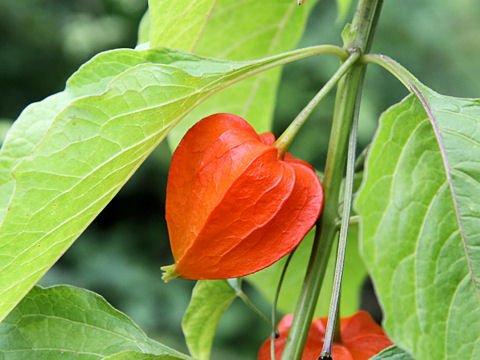Category: Traditional Chinese Medicine
-

Cold-Food Powder or Five Minerals Powder, poisonous psychoactive drug popular during the Six Dynasties (220–589) and Tang dynasty (618–907)
Cold-Food Powder (Chinese: 寒食散; pinyin: hánshísǎn; Wade–Giles: han-shih-san) or Five Minerals Powder (Chinese: 五石散; pinyin: wǔshísǎn; Wade–Giles: wu-shih-san) was a poisonous psychoactive drug popular during the Six Dynasties (220–589) and Tang dynasty (618–907) periods of China. Terminology Both Chinese names hanshisan and wushisan have the suffix -san (散, lit. “fall apart; scattered”), which means “medicine in powdered form” in Traditional Chinese medicine. Wushi (lit. “five rock”) refers to the component mineral drugs, typically: fluorite, quartz, red bole clay, stalactite, and sulfur. Hanshi (lit. “cold food”) refers to eating cold foods and bathing in cold water…
-

Alkekengi aka Chinese lantern is a species of flowering plant in the nightshade family
Scientific classification Kingdom: Plantae Clade: Tracheophytes Clade: Angiosperms Clade: Eudicots Clade: Asterids Order: Solanales Family: Solanaceae Subfamily: Solanoideae Tribe: Physaleae Genus: AlkekengiMill. Species: A. officinarum Binomial name Alkekengi officinarumMoench Alkekengi officinarum, the bladder cherry, Chinese lantern, Japanese-lantern, strawberry groundcherry, or winter cherry, is a species of flowering plant in the nightshade family Solanaceae. It is a close relative of the new world Calliphysalis carpenteri (Carpenter’s groundcherry) and a somewhat more distant…
-

Rubia cordifolia aka common madder or Indian madder
Rubia cordifolia, often known as common madder or Indian madder, is a species of flowering plant in the coffee family, Rubiaceae. It has been cultivated for a red pigment derived from roots. Common names of this plant include manjistha in Sanskrit, Marathi, Kannada and Bengali, majith in Hindi and Gujarati, བཙོད་ in Tibetan, tamaralli in Telugu, manditti in Tamil. Description It can grow to 1.5 m in height. The evergreen leaves are 5–10 cm long and 2–3 cm broad, produced in whorls of 4-7 starlike around…
NOTES
- 🧬 Disease Table with Low Sodium Connection
- 🧂 Sodium Reduction and Sodium Replacement: A History of Reformulation and Exploding Diseases, Including Many Diseases Unheard of Before Deadly Sodium Policies
- 🧂 The DEADLY 1500 mg Sodium Recommendation predates the WHO’s formal global sodium reduction push by nearly a decade (and it’s even worse than that)
- 🧬 What Is Beta-Glucuronidase?
- When Sugar Was Salt: Crystalline Confusion and the Covenant of Sweetness
Tags
ADAM ASPARTAME Birds Blood Bones Brain Bugs Cancer Columba Cows crystallography Death Death cults Eggs Etymology Gastrin Gold Growth hormone History Hormones Insulin Liver Mere Perplexity Metal Monkey Business Mythology Paracetamol Plants Poison Pregnancy Protein Religion Reproduction Rocks Salt Slavery Snakes Sodium the birds and the bees Thiocyanate Tobacco Tylenol Underworld Venom zinc

